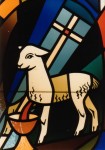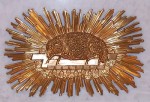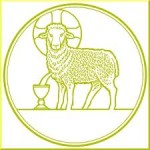 We spent our assembly time together here at Central yesterday considering the weird passage in Genesis 15 about the blood path ceremony between God and Abram. All the pieces of animal, all the blood, the thick and dreadful darkness, the two symbols representing God passing between the pieces.
We spent our assembly time together here at Central yesterday considering the weird passage in Genesis 15 about the blood path ceremony between God and Abram. All the pieces of animal, all the blood, the thick and dreadful darkness, the two symbols representing God passing between the pieces.
Clearly, God was promising Abram that God’s promises about giving Abram many descendents and lots of land and, eventually, blessing all the nations of the earth by his seed were trustworthy. God was going to be true to his word. And he staked his life on it by walking between the bloody pieces of the sacrificial animals. God used a very common practice, this ceremony with which everybody was familiar, to demonstrate his commitment to his word.
If what is explicit in Genesis 17:1, that Abram had to be blameless and live in perfection before the Lord, was understood at this time to be Abram’s part of the covenant — and I believe it was — then it’s remarkable that God walked the path between the pieces twice. The smoke and the fire, two theophanies representing YHWH Lord, both pass through the blood. God stands in for Abram. He walks in Abram’s place. The promise from the Lord, in addition to the kids and the land and the Messiah is that God is going to pay for his people’s sins. God pays the price whether he or Abram violates the covenant. Either way, the penalty is on God. Whenever and however the covenant gets broken, when it’s broken, God dies.
The significance of this powerful picture of God walking the blood path in Genesis 15 cannot be overstated. Yes, what God has promised he will certainly do. In the scheme of Genesis and the rest of the Torah, this story goes a long way in reminding us that God overcomes seemingly insurmountable obstacles — barren wombs, enemies in the promised land, the sin of his people — to keep his word. Yes. But it’s so much more than that, too.
 God’s perfect promises are free gifts to his people. God is the One who initiates the relationship with us and provides for us what is needed to maintain it. We bring nothing to the table. The Father desires to bond eternally with people who consistently reject him. And he’s willing to prove his devotion to the relationship by offering his own life. Not only that, but the Lord is willing to pay the price himself for the covenant failures of man.
God’s perfect promises are free gifts to his people. God is the One who initiates the relationship with us and provides for us what is needed to maintain it. We bring nothing to the table. The Father desires to bond eternally with people who consistently reject him. And he’s willing to prove his devotion to the relationship by offering his own life. Not only that, but the Lord is willing to pay the price himself for the covenant failures of man.
And God’s promise is unconditional. It was not dependent on Abram at all. The covenant stands no matter what the people believe or what they practice. The fulfillment does not depend on man’s faith or faithfulness. God’s “I AM” is perfectly adequate for man’s “I am not.” We can’t perfectly keep the terms of our covenant with God. It’s impossible. We are entirely unable to walk before the Lord and be blameless. But, praise God, that’s not the end of the matter. Our Father made the provision for us long ago. His walking through the blood symbolizes his willingness to stand in for us, to do what is necessary to cover for us, when we violate the terms of the covenant.
At the end of the day, Abram was assured that his own future and the futures of his children and descendents were firmly in the hands of the covenant God. “On that day,” Genesis 15:18 says, “the Lord made (lit: cut) a covenant with Abram.” The point remains the same for you and me under the renewed covenant: God’s word is dependable. It’s perfect. The Lord keeps his promises. Our Father is faithful; and very, very good.
~~~~~~~~~~~~~~~~~~~~~~~~~~~~~~~~~~~
 The seeds of yesterday’s sermon were planted in me by a teaching I heard from Ray Vander Laan about seven years ago. A year later, Dr. Mark Shipp assigned the Genesis 15 text to me for an exegetical research project at Austin Grad. Vander Laan inspired me. Shipp challenged me. And now this picture in Genesis 15 is a part of me. You can read Vander Laan’s work on the subject here. You can read my exegetical paper on the passage by clicking here: Genesis 15 Exegesis
The seeds of yesterday’s sermon were planted in me by a teaching I heard from Ray Vander Laan about seven years ago. A year later, Dr. Mark Shipp assigned the Genesis 15 text to me for an exegetical research project at Austin Grad. Vander Laan inspired me. Shipp challenged me. And now this picture in Genesis 15 is a part of me. You can read Vander Laan’s work on the subject here. You can read my exegetical paper on the passage by clicking here: Genesis 15 Exegesis
~~~~~~~~~~~~~~~~~~~~~~~~~~~~~~
 It turned out to be a full weekend project. In and around Thanksgiving food, football, and family; in between Christmas decorating and shopping; before and after church and study and movies and games; Valerie had to write a poem for school. This poem had to be based on an earlier project in which she had described herself by using dualities found in images and ideas from nature. Among other things, Valerie had written about fire, which produces energy and warmth, yet also displays a tendency to ignore boundaries and be destructive. She had mentioned Spring, contrasting songs and flowers against the inevitable wind and storms. There were also the complexities of a diamond: multi-faceted, hard, yet submitting to the gem-cutter’s blade. She also sees herself in the Azaleas: striking in their brilliance, yet so stinking high-maintenance. But could she express all of this in a poem?
It turned out to be a full weekend project. In and around Thanksgiving food, football, and family; in between Christmas decorating and shopping; before and after church and study and movies and games; Valerie had to write a poem for school. This poem had to be based on an earlier project in which she had described herself by using dualities found in images and ideas from nature. Among other things, Valerie had written about fire, which produces energy and warmth, yet also displays a tendency to ignore boundaries and be destructive. She had mentioned Spring, contrasting songs and flowers against the inevitable wind and storms. There were also the complexities of a diamond: multi-faceted, hard, yet submitting to the gem-cutter’s blade. She also sees herself in the Azaleas: striking in their brilliance, yet so stinking high-maintenance. But could she express all of this in a poem?
Oh, yes she can.
It’s beautiful. I suggested she title it “A Song Unfinished.” She went with “The Stonecutter’s Project.” It describes my little Valerie perfectly. A bundle of energy and talent and unlimited potential. Enjoy.
She crackles, she sizzles, inspires as she dances;
she daringly spreads as she leaps at new chances.
Fiery, bold, contagious.
Careless, impulsive, outrageous.
A tendency to both warm and consume as she advances.
A skip in her Vans and a spritz of perfume;
like Spring, she has sprung, entirely in bloom.
Songbirds, shamed by her voice.
But beware of her other noise:
the lightening and thunder of an alternate mood.
Like the Azalea in season, so striking, so pink;
it takes the right mix of rich soil and zinc.
P, B, and Js.
Grilled cheese and Lays.
For Valerie, nothing more, nothing less, and a D. P. to drink.
Like the diamond that dazzles through each of its facets,
the word “brilliance” defines and sums up her assets.
Unique, strong, true to her pledges.
Stubborn, steadfast, still rough around the edges.
Continually refined by the Stonecutter’s tools, a polished gem with no regrets.
Peace,
Allan
Leave a Reply